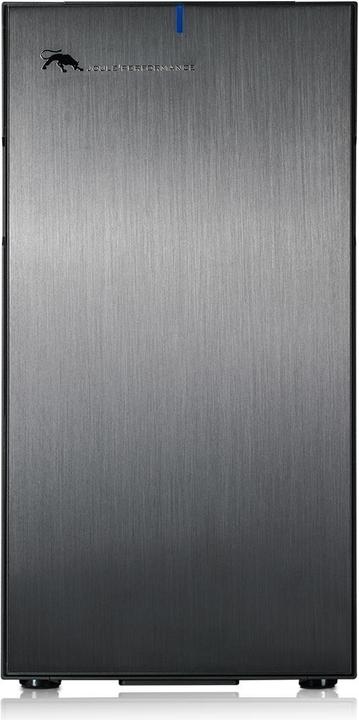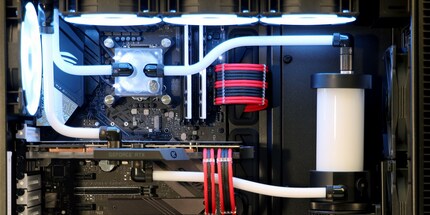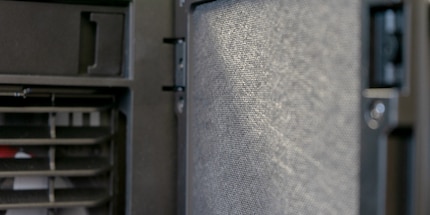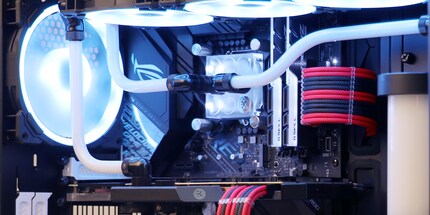

Joule Performance Glados 2: Awesome part with the (still) wrong graphics card

A water-cooled gaming PC from Joule Performance with Intel i9-9900K and an RTX 2080 - sounds good? And it is. The Glados 2 not only looks great, but also has plenty of power under the bonnet - even though it still has the wrong graphics card. I tested the prototype.
It's simply a joy to marvel at the tubes with the white coolant. They are perfectly curved. I particularly like the first and last tubes of the circuit, which meander in a slight S through the inside of the housing. I could watch them for hours. The white on the otherwise dark components really comes into its own.

With all the praise for the beautiful workmanship, I also have to criticise something. Why Joule Performance opted for red and black cables is a mystery to me. They look like a foreign body. That's actually all the negative things I have to say about the exterior of the new gaming PC. Fortunately, you can switch off the flashing of the RGB fans or at least set them to white so that they match the colour scheme.
I look at these components through the tempered glass of the Fractal-Define R6 case:
- Intel Core i9-9900K with 3.6 GHz
- ASUS ROG Strix Z390-F Gaming
- G.Skill Trident Z RGB G.Skill 2 × 8 GB RAM
- ASUS Strix RTX 2080 with 8 GB graphics memory
- Samsung 970 PRO (512GB, M.2 2280)
- WD Black (2TB)
- Custom water cooling with components from EK Water Blocks
My test product is still a prototype. The final product will come with 32 GB RAM and AiO water cooling
.

The Glados 1 is one size bigger. It comes with custom water cooling and the ASUS Strix RTX 2080 Ti.
Connections
You get plenty of connectivity thanks to the mainboard, graphics card and case. The midi tower has microphone and headphone connections as well as one USB 3.1 type C, two USB 3.0 and two USB 2.0. The mainboard provides you with four USB 3.1 Gen 2 ports, three of which are type A and one type C. There are also two USB 2.0 and two USB 3.0 ports.
In addition to all the USBs, there are also various audio connections and, of course, the video connections on the graphics card are state of the art. With three DisplayPort 1.4 and one HDMI 2.0b, you can connect enough monitors. There is also USB Type-C support.
Emissions

The PC never got loud during gaming sessions and benchmarks. The heat development was also kept within limits. The CPU briefly warmed up to over 70 degrees, but cooled down again quickly. In general, the system runs very smoothly and reliably.
Performance
A pre-production sample of the Intel Core i9-9900K is installed in my test device. The performance is therefore not comparable with the final product. The production model will certainly run a little faster. The RTX 2080 is a new graphics card model in the Glados 2, so let's see what the state-of-the-art components can do.
CPU [[image:17856575 "The CPU under the cooling block."]]
The Core i9-9900K is the latest consumer CPU from Intel. It has eight cores, up to 16 threads and 16 MB L3 cache. The processor is manufactured using the 14nm++ process. The power consumption is 95 W. Intel specifies the maximum clock frequency as 5.0 GHz with three active cores. So much for the theory. How does the processor perform in practice? I carried out four CPU benchmarks
.
I used Cinebench R15 to test the floating point performance. The i9-9900K achieves a score of 2039 points. This makes it one of the fastest consumer CPUs in Cinebench. By comparison, last year's i7-8700K achieved a score of 1743, making the i9-9900K around 15 per cent faster.
Geekbench 4 shows you the performance of the CPU in everyday use. The advantage: Geekbench not only tests multi-core performance, like Cinebench R15, but also gives you information about single-core performance. The Intel i9-9900K achieves 6106 points in Single Core and 32,562 in Multi Core. The fastest i9-9900K achieved a Single Core score of around 6900 and a Multi Core score of around 38,000. The installed processor therefore falls slightly behind here. This may be due to the fact that a pre-production sample is installed in my test device.
I use Fire Strike and Time Spy to test the processor's gaming performance. The CPU achieves 24,691 points in Fire Strike and 10,990 points in Time Spy, with the top performers in the latter at just under 14,000 points. However, these are overclocking results. I didn't want to miss out on the fun and also turned the screw a little. I used a few settings from this guideline. With minimal changes, I was able to increase the score by 300 points. The i9-9900K installed in the Fire Strike is around 5000 points behind the best. These are also overclocking results. With minor adjustments, I still achieved 26,247 points.
GPU [[image:17856576 "The graphics card with water cooling."]]
The ASUS Strix RTX 2080 offers 8 GB GDDR6 memory, 2944 CUDA cores, 368 tensor cores and 46 raytracing cores. This means it beats its predecessor, the 1080, by 15 per cent on the sheet. To test its performance, I run Geekbench 4, Fire Strike and Time Spy.
In Fire Strike, the GPU achieved a score of 25,967, with the best comparable result clearly ahead at 29,408. Overclocking was also used here. With a few adjustments, I achieved up to 26,430 points. But I'm sure there's room for more. In Time Spy, I achieved 10,599 without overclocking settings and 11,024 with overclocking settings. That puts me 4400 points behind the best comparable result.
In the Geekbench 4 computing benchmark, the installed RTX 2080 falls behind other 2080s. I achieved 295,524 points, while the front-runner scored 426,557.
Gaming performance
In addition to these benchmarks, I naturally also test the Glados 2 with various games. I focus on 4K and 2K resolution and always select the highest default settings. I also test two games - "Far Cry 5" and "Deus Ex: Mankind Divided" - with and without a few overclocking settings.
"Far Cry 5"
The fifth instalment in the "Far Cry" series is a real VRAM hog. At 2K resolution, six and a half gigabytes of the available eight gigabytes are already occupied. This is also reflected in the performance. The game's internal benchmark renders at an average of 39 fps. The game is therefore playable, but I am a long way from 60 frames.
The VRAM greed is even more extreme at 4K. The VRAM is completely overloaded with 9.7 GB. I only achieve an average of 17 fps. The game is not playable like this.
Overclocking doesn't bring much more either. Sure, I can't conjure up more RAM with it. I achieve 20 fps in the benchmark with 4K and 45 fps in the 2K benchmark.
"Deus Ex: Mankind Divided"
Luckily, the fourth instalment about the protagonist Adam Jensen is not quite as addicted to VRAM as "Far Cry 5". That's why the RTX 2080 handles it better. I achieve an average of 27 fps in the 4K benchmark. The game is playable, albeit not at a high frame rate. With a little overclocking, I reach 30 fps.
At 2K, the game runs extremely smoothly at around 52 fps. With overclocking, I achieved 55 fps. If you work with it a little more, you can easily achieve 60 fps.
"Ashes of Singularity"
The game reacts strongly to many cores. It is therefore also an excellent way to test the new 8-core. I achieved an average frame rate of 70 fps in the 2K benchmark. In the 4K benchmark, it's still 63 fps.
"Battlefield 5" [[image:17856795 "«Battlefield 5» with ray tracing is simply fun."]]
Of course, I'm also testing a very recent game. "Battlefield 5" is one of the first games to support ray tracing. I tested it with and without ray tracing.
Without ray tracing, I was able to play at an average of 50 fps in 4K. In 2K it was already around 90 fps. With ray tracing, it's a little less fast. In 4K it runs at an average of 28 fps. However, the frame rate collapses completely in between and there is a lot of stuttering. It looks a lot better in 2K. I have a stable frame rate of 50 fps on average. "Battlefield" looks even better. I'm a bad shooter player. Ray tracing makes me even worse now, because I can't stop marvelling at the awesome lighting effects.
Conclusion

The Glados 2 is a really great gaming machine. You really get your money's worth and will be equipped for years to come.
Which brings us to the topic of the coming years. The PC has to admit to some weaknesses. For example, "Far Cry 5" doesn't really run smoothly. This is due to the limited VRAM for this game. Too bad the RTX 2080 doesn't come with 11 GB of VRAM, then "Far Cry 5" would also run smoothly in 4K. So you'll struggle with really VRAM-hungry games or won't be able to play them in 4K.
I was pleasantly surprised by ray tracing. Not only does "Battlefield 5" look a lot prettier, it also runs smoothly in 2K. I wouldn't have thought it possible that I could already play a ray-traced game in 2K without any problems. You really are prepared for the future here. In terms of graphics, we're in for a great time.
The built-in pre-production CPU is already very powerful. In the benchmarks, it has dropped less than I would have expected compared to the final product. And thanks to the water-cooled system, you can certainly get even more out of the machine with overclocking. That's not such a big deal these days with the UEFI from Asus.


From big data to big brother, Cyborgs to Sci-Fi. All aspects of technology and society fascinate me.



